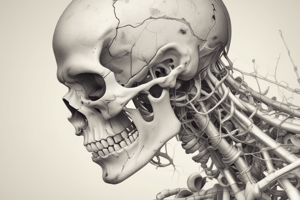Podcast
Questions and Answers
What is the term for the layer of mucous membrane found in the stomach?
What is the term for the layer of mucous membrane found in the stomach?
- Pernicious anaemia
- Gastric mucosa (correct)
- Mucosa
- Gastric
What is the term for the loss of full control of the body's movements?
What is the term for the loss of full control of the body's movements?
- Pernicious anaemia
- Pallor
- Ataxia (correct)
- Glossitis
What is the term for a rash of purple spots on the skin caused by internal bleeding from small blood vessels?
What is the term for a rash of purple spots on the skin caused by internal bleeding from small blood vessels?
- Gastric mucosa
- Purpura (correct)
- Glossitis
- Jaundice
What is the term for the thin layer that covers the front of the eye and the inside of the eyelids?
What is the term for the thin layer that covers the front of the eye and the inside of the eyelids?
What is the term for a medical condition in which the skin and the white parts of the eyes become yellow?
What is the term for a medical condition in which the skin and the white parts of the eyes become yellow?
What is the term for a medical condition characterized by a lack of colour?
What is the term for a medical condition characterized by a lack of colour?
What is the term for the bone that forms the lower jaw?
What is the term for the bone that forms the lower jaw?
What is the term for the bone that forms the shoulder blade?
What is the term for the bone that forms the shoulder blade?
What is the term for a medical condition characterized by the breakdown of red blood cells?
What is the term for a medical condition characterized by the breakdown of red blood cells?
What is the term for the ability to feel vibrations?
What is the term for the ability to feel vibrations?
Flashcards are hidden until you start studying
Study Notes
Fractures and Bones
- A patella is also known as a kneecap
- A tibia is also known as a shinbone
- A fracture is a partial or complete break in the bone
- A pathological fracture is a broken bone caused by disease, often by the spread of cancer to the bone
- Types of fractures:
- Greenstick: a bone that bends and cracks, but does not break completely
- Displaced: a bone that breaks into two or more pieces and moves out of alignment
- Comminuted: a broken bone that breaks into more than two pieces
- Impacted: two pieces of a fractured bone that are driven into each other
- Open (compound): a fracture with an open wound or break in the skin near the site of the broken bone
- Fatigue (stress) fracture: tiny cracks in a bone caused by repetitive stress or overuse
Treatment of Fractures
- Reduction: the correction of a fracture, replacing the fragments in their anatomical position if they are displaced
- Fixation: a surgical procedure that stabilizes and joins the ends of fractured bones using mechanical devices
- Fracture union: a gradual, continuous process whereby the strength of a broken bone is restored by bone regeneration
Symptoms and Signs
- Symptoms: changes in the body or mind that indicate illness
- Signs: what a doctor finds on examining a patient, also known as findings
- Presenting symptom: the symptom that causes a patient to visit a doctor
- Describing symptoms:
- Tiredness: feeling of wanting to sleep or rest
- Lethargy: state of having no energy or enthusiasm for doing things
- Fatigue: feeling extremely tired
- Lassitude: lack of energy
- Malaise: general feeling of being unwell
- Anorexia: mental illness causing extreme control of food intake, leading to dangerous weight loss
Blood
- Full blood count (FBC): measures the amount of haemoglobin, number of red blood cells, white blood cells, and platelets in a sample of blood
- Erythrocyte sedimentation rate (ESR): measures how quickly red blood cells fall to the bottom of a sample of blood
- Anaemia: medical condition characterized by too few red cells or too little haemoglobin in the blood
- Types of anaemia:
- Severe anaemia: may increase the risk of developing complications affecting the heart or lungs
- Leukemia: serious disease characterized by too many white blood cells
- Aplastic anaemia: rare but serious blood condition where bone marrow cannot make enough new blood cells
- Iron deficiency anaemia: condition where a lack of iron in the body leads to a reduction in red blood cells
Studying That Suits You
Use AI to generate personalized quizzes and flashcards to suit your learning preferences.




